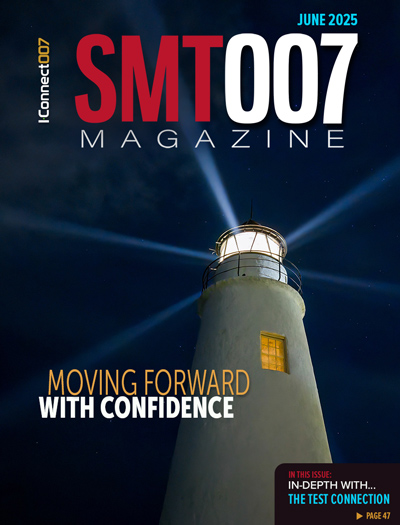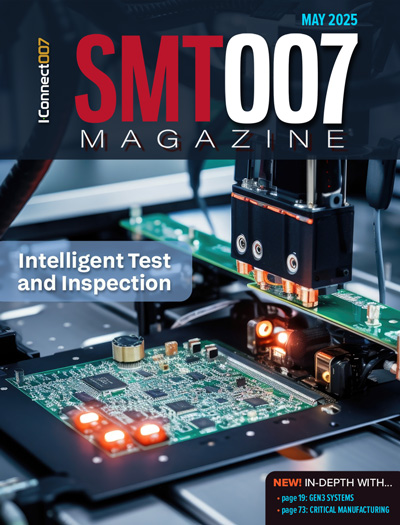-

- News
- Books
Featured Books
- smt007 Magazine
Latest Issues
Current Issue
What's Your Sweet Spot?
Are you in a niche that’s growing or shrinking? Is it time to reassess and refocus? We spotlight companies thriving by redefining or reinforcing their niche. What are their insights?

Moving Forward With Confidence
In this issue, we focus on sales and quoting, workforce training, new IPC leadership in the U.S. and Canada, the effects of tariffs, CFX standards, and much more—all designed to provide perspective as you move through the cloud bank of today's shifting economic market.

Intelligent Test and Inspection
Are you ready to explore the cutting-edge advancements shaping the electronics manufacturing industry? The May 2025 issue of SMT007 Magazine is packed with insights, innovations, and expert perspectives that you won’t want to miss.
- Articles
- Columns
- Links
- Media kit
||| MENU - smt007 Magazine
X-Ray Inspection of Lead and Lead-Free Solder Joints
July 31, 2017 | Glen Thomas, Ph.D., and Bill Cardoso, Ph.D., Creative Electron Inc.Estimated reading time: 13 minutes
Figure 12: Oblique view of a BGA assembled using lead-free solder. Note the size and shape of the balls in the first row. The balls on the left are correctly connected, while the balls on the last column in the right are either open or head-in-pillow (HIP). This side view indicates a planarity problem with this assembly, which means that the BGA must be removed and reworked.
Figure 13: Lead solder BGA with several of its balls showing excessive voiding which indicate that this part should be reworked. The irregular shape of some of the balls suggests irregular reflow.
Figure 14: Lead-free solder BGA with several of its balls showing excessive voiding which indicate that this part should be reworked.
CONCLUSIONS
In this paper, we demonstrated some effects on an X-ray inspection system the imaging characteristics for a few of the lead-free solders. A theoretical analysis based upon X-ray attenuation characteristics showed that there is almost no difference between eutectic tin-lead solder and 42Sn/58Bi. We also determined that predominantly Sn based solders lead to a contrast about 88% of that for eutectic tin-lead solder. Consequently, we expect little variation in the inspectability of joints made with these alternative solders. We additionally provided some images of real solder joints constructed with these different compounds. These images showed the expected contrast variations.
Although the analysis performed in this paper does not constitute a rigorous proof, it indicates that usage of a number of lead-free solders should not seriously degrade the X-ray inspection imaging capability.
REFERENCES
1. Hupfer, M., Nowak, T., Brauweiler, R., Eisa, F., and Kalender, W.A. (2012). “Spectral optimization for micro-CT”. Med. Phys.39, 3229–3239.
2. Attix, Frank H. “Introduction to Radiological Physics and Radiation Dosimetry”. John Wiley & Sons, New York, 1986.
3. Cullen, D. E., et. al. “Tables and Graphs of Photon-Interaction Cross Sections Derived from the LLNL Evaluated Photon Data Library (EPDL), Z=1-50”. Lawrence Livermore National Laboratory, Livermore, CA, Vol. 6, Part A, Rev. 4, 1991.
4. Cullen, D. E., et. al. “Tables and Graphs of Photon-Interaction Cross Sections Derived from the LLNL Evaluated Photon Data Library (EPDL), Z=50-100”. Lawrence Livermore National Laboratory, Livermore, CA, Vol. 6, Part B, Rev. 4, 1991.
5. Bastecki, Chris. “A Benchmark Process for the Lead-Free Assembly of Mixed Technology PCBs”. Technical Brief, Alpha Metals Inc., January 1997.
Editor's Note: This paper was originally published in the proceedings of SMTA International, 2016.
Page 5 of 5Suggested Items
Driving Innovation: Direct Imaging vs. Conventional Exposure
07/01/2025 | Simon Khesin -- Column: Driving InnovationMy first camera used Kodak film. I even experimented with developing photos in the bathroom, though I usually dropped the film off at a Kodak center and received the prints two weeks later, only to discover that some images were out of focus or poorly framed. Today, every smartphone contains a high-quality camera capable of producing stunning images instantly.
Hands-On Demos Now Available for Apollo Seiko’s EF and AF Selective Soldering Lines
06/30/2025 | Apollo SeikoApollo Seiko, a leading innovator in soldering technology, is excited to spotlight its expanded lineup of EF and AF Series Selective Soldering Systems, now available for live demonstrations in its newly dedicated demo room.
Indium Corporation Expert to Present on Automotive and Industrial Solder Bonding Solutions at Global Electronics Association Workshop
06/26/2025 | IndiumIndium Corporation Principal Engineer, Advanced Materials, Andy Mackie, Ph.D., MSc, will deliver a technical presentation on innovative solder bonding solutions for automotive and industrial applications at the Global Electronics A
Fresh PCB Concepts: Assembly Challenges with Micro Components and Standard Solder Mask Practices
06/26/2025 | Team NCAB -- Column: Fresh PCB ConceptsMicro components have redefined what is possible in PCB design. With package sizes like 01005 and 0201 becoming more common in high-density layouts, designers are now expected to pack more performance into smaller spaces than ever before. While these advancements support miniaturization and functionality, they introduce new assembly challenges, particularly with traditional solder mask and legend application processes.
Knocking Down the Bone Pile: Tin Whisker Mitigation in Aerospace Applications, Part 3
06/25/2025 | Nash Bell -- Column: Knocking Down the Bone PileTin whiskers are slender, hair-like metallic growths that can develop on the surface of tin-plated electronic components. Typically measuring a few micrometers in diameter and growing several millimeters in length, they form through an electrochemical process influenced by environmental factors such as temperature variations, mechanical or compressive stress, and the aging of solder alloys.


